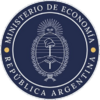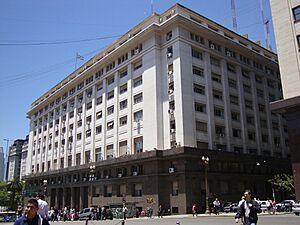Ministry of Economy (Argentina) facts for kids
| Ministerio de Economía | |
 |
|
 Palacio de Hacienda, headquarters |
|
| Ministry overview | |
|---|---|
| Formed | 1854 (as the Ministry of the Treasury) |
| Jurisdiction | Government of Argentina |
| Headquarters | Palacio de Hacienda Buenos Aires |
| Employees | 4,000 (2009) |
| Annual budget | $ 616,641,458,521 (2021) |
| Minister responsible |
|
| Child agencies |
|
| Website | argentina.gob.ar/economia |
The Ministry of Economy (Spanish: Ministerio de Economía) is a very important part of the Government of Argentina. It's like the country's money manager. This ministry helps decide how Argentina's economy works. It also handles the country's money and financial plans.
This ministry is one of the oldest parts of the Argentine government. It started way back in 1854. Back then, it was called the Ministry of the Treasury. The current minister in charge is Luis Caputo, who began his work in 2023.
The Ministry's Home: Palacio de Hacienda
The Ministry of Economy works from a large, important building. It is called the Palacio de Hacienda. This building is in Buenos Aires, the capital city of Argentina. It was built in 1939 and has 14 floors.
The Palacio de Hacienda is located in the Montserrat neighborhood. It faces the Casa Rosada, which is where the President works. It is also close to the Ministry of Defense. The main hall inside the building has beautiful paintings. These were made by Antonio Pibernat.
How the Ministry Grew Important
The role of managing Argentina's money officially began in 1826. That's when Bernardino Rivadavia named Salvador María del Carril as the first Minister of Hacienda. Over time, especially after 1880, the ministry became very powerful. This was when Argentina saw a lot of growth. Money from other countries, international trade, and many new people moving to Argentina helped the economy.
The ministry became responsible for collecting customs taxes. These taxes were a big part of the government's money back then. It also oversaw the Central Bank, which manages the country's money supply. Ministers often made big economic decisions with the President's approval.
The ministry's power grew even more in 1991. It took over the responsibilities of the Minister of Public Works. This helped with plans to sell off some government-owned businesses. Later, in 2008, a new Production Ministry was created. This meant the Ministry of Economy focused more on financial matters. In 2009, the ministry had a budget of about US$1.7 billion. It also had over 4,000 people working for it.
Images for kids


